- Joined
- Oct 1, 2023
- Messages
- 1,961
- Points
- 488

 |
As a way to introduce our brass coins to the community, we will raffle off a free coin during the month of August. Follow link ABOVE for instructions for entering. |
 |


Get a decent vise....and if you plan on milling round pieces, a rotary clamp ( dividing attachment) helps....but you can just use mechanical clamps (stepping blocks)I purchased a mini compound table from Amazon to improve accuracy on making my parts.
Could someone with experience using these point me to the accessories I need to mount the parts to the table.
I'm excited to use this table to help overcome lack of skill and shaky hands.
Thank you,
Ted
View attachment 520622
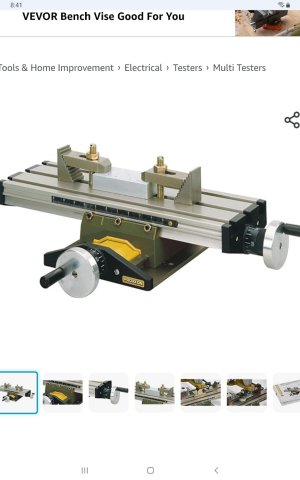
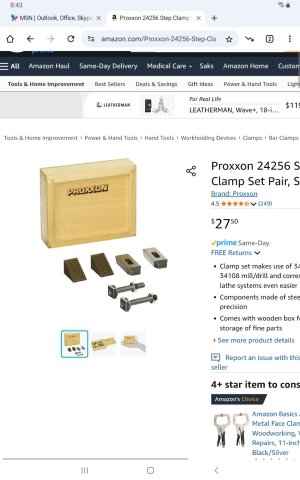
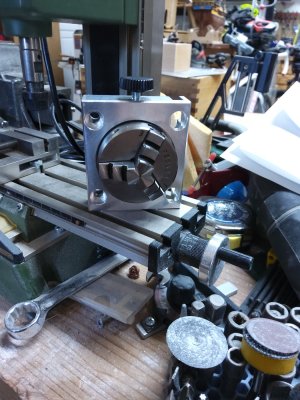
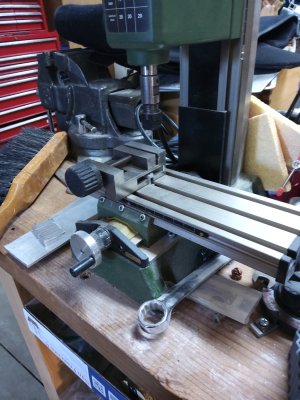

Depending on what you're trying to mill. If you are looking for parallelism or keeping thing absolutely square, tape won't do it.I think some people have used 2 sided tape to hold down part as well. I have never tried it but it is something that I want to try.

That vise looks nice and low.Hiya Ted.
I mounted a flat vise to it. It'll be a learning experience.

regards
Mike

ThanksI ordered it a while ago from Ali Express. Once it's snugged to holding something there's no issue. It'll have an easy life with me anyway.th





Thank youWith your x-y table and the right cutter you can now make your own vee v groove holding board. Depending on the collet size of what you are using to rotate the cutter, since you’ll be cutting wood you can use a v groove router bit or possibly a Dremel cutting tool.
These home made jigs should be considered to be semi-disposable, and in this case that piece of wood that you are trying to shape should have a “ disposable end.” That way you can nail one end to the groove in your cutting board to keep the piece from rotating. When done, cut off the end.
Roger

I have a lot of 3mm and 4mm spars to make in addition to 6.5mm masts.Can you perhaps tell us what you have in mind for the items you will be using it for?
It’s a bit of a general purpose tool, like a workbench. It can be used for all manner of things, often with adaptations specific to the parts being manufactured so it would help provide better advice if you had particular ideas.
J
Truth be told, that sounds like what you need isn't an X-Y table, so much as a lathe with a decent taper attachment (or a tailstock that you can move from side to side, although that's a royal pain to set up.) Turn the round sections to the desired length and taper, leaving the sections to be squared standing proud. The take the spar and mill the flats as required. Actually, once you've turned the round tapered sections, you can work the flats with a decent hand plane very easily. You might want to mount a plate or piece of wood to the side of your plane to ensure 90-degree angles, or whatever other angle you desire.I have a lot of 3mm and 4mm spars to make in addition to 6.5mm masts.
The materials provided are 8.5mmdowels for the mast and 6mm for the spars.
I want to milk these close to size.
Some of the masts have squared ends and some spars have to be octagonal in the centers.
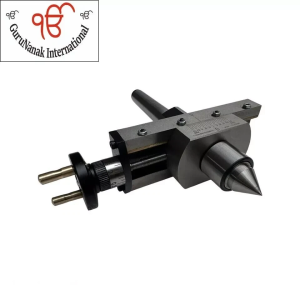

I agree. I don't have a lathe. Only a Dremel rotary tool with the drill press attachment and a battery powered drill.Truth be told, that sounds like what you need isn't an X-Y table, so much as a lathe with a decent taper attachment (or a tailstock that you can move from side to side, although that's a royal pain to set up.) Turn the round sections to the desired length and taper, leaving the sections to be squared standing proud. The take the spar and mill the flats as required. Actually, once you've turned the round tapered sections, you can work the flats with a decent hand plane very easily. You might want to mount a plate or piece of wood to the side of your plane to ensure 90-degree angles, or whatever other angle you desire.
If you have access to a machinist's lathe with a #2 Morse taper in the tailstock, the below offsetting taper turning device is worth its weight in gold: https://www.ebay.com/itm/176398188759 About $70.00 on eBay.
View attachment 520756
You can glue a strip of sandpaper to a flat block and use that on your spar chucked in your drill to get a flat taper. You'll have to do it by eye and check your dimensions frequently to "sneak up on it."I agree. I don't have a lathe. Only a Dremel rotary tool with the drill press attachment and a battery powered drill.


I'm kinda struck with the dowels. I don't have any flat stock.or a saw to cut it square. I'm going to figure out how to make a vee block thoughDepending on what other tools that you have, I’d scrap the dowels and cut pieces with a square cross section from straight grained stock. It’s much easier then to taper these square cross sectioned pieces. Then put each piece in your homemade vee block and plain off the corners to get pieces with an octagonal cross section. Lightly plane again to get sixteenth sided cross sections. From this point you can sand it round with sandpaper on a block.
Roger
